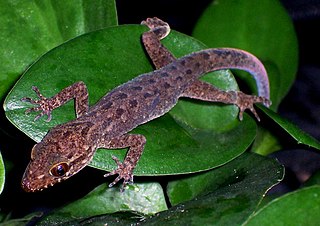
Cyrtodactylus is a diverse genus of Asian geckos, commonly known as bent-toed geckos, bow-fingered geckos, and forest geckos. The genus has at least 300 described species as of 2020, which makes it the largest of all gecko genera.
Bavayia is a genus of lizards in the family Diplodactylidae. Species in the genus Bavayia are also known commonly as New Caledonian geckos or bavayias. The genus is native to the remote New Caledonia and Loyalty Islands. The 12 species are moderately small to medium-sized geckos, and are distinguished from other genera by their tail length and the shape of their digits.

Diplodactylinae is a subfamily in the family Diplodactylidae sensu lato. In some classifications, it is equivalent to family Diplodactylidae, which is in the infraorder Gekkota. There are 142 species in seventeen genera.

The Diplodactylidae are a family in the suborder Gekkota (geckos), with over 150 species in 25 genera. These geckos occur in Australia, New Zealand, and New Caledonia. Diplodactylids are the most ecologically diverse and widespread family of geckos in both Australia and New Caledonia, and are the only family of geckos found in New Zealand. Three diplodactylid genera have recently been split into multiple new genera
Bavayia crassicollis, also known as the strand bavayia is a gecko endemic to the Loyalty Islands in New Caledonia.
Bavayia cyclura, also known as Günther's New Caledonian gecko or the forest bavayia is a gecko endemic to Grande Terre and Ile des Pins including their neighboring islets in New Caledonia.
Bavayia exsuccida, also known as the Sclerophyll bavayia, is a species of geckos endemic to North Province, New Caledonia.
Bavayia geitaina, also known as the gracile bavayia, is a species of geckos endemic to southern Grande Terre in New Caledonia.
Bavayia ornata, also known as the ornate bavayia is a gecko endemic to mountain ranges of Grande Terre in New Caledonia.
Bavayia pulchella, also known as the pretty bavayia, is a species of geckos endemic to Grande Terre in New Caledonia.
Bavayia robusta, also known as the robust forest bavayia, is a species of geckos endemic to Grande Terre and Île des Pins in New Caledonia.
Bavayia sauvagii, also known commonly as Sauvage's bavayia and Sauvage's New Caledonian gecko, is a species of lizard in the family Diplodactylidae. The species is endemic to New Caledonia.
Bavayia septuiclavis, also known as Sadlier's New Caledonian gecko or the pale-stripe bavayia, is a gecko endemic to southern Grande Terre in New Caledonia.
New Caledonian gecko may refer to any of the below, both genera placed in the Diplodactylidae family, and found in New Caledonia:
Dierogekko thomaswhitei, also known commonly as White's nimble gecko and the Taom striped gecko, is a species of lizard in the family Diplodactylidae. The species is endemic to New Caledonia.

Pygopodoidea is a gecko superfamily and the only taxon in the gekkotan subclade Pygopodomorpha. The clade includes three Australasian families: Diplodactylidae, Carphodactylidae, and Pygopodidae. Traditional gekkotan systematics had considered Diplodactylidae and Carphodactylidae as subfamilies of the family Gekkonidae, but recent molecular work have placed Pygopodidae within Gekkonidae making it paraphyletic. These analyses have shown support of Pygopodidae and Carphodactylidae being sister taxa, with Diplodactylidae occupying a basal position in Pygopodoidea.

Grevillea montana, also known as the Hunter Valley grevillea or mountain grevillea, is a species of plant in the protea family that is endemic to Australia. It is closely related to Grevillea arenaria. The specific epithet montana is Latin for “of the mountains”.




